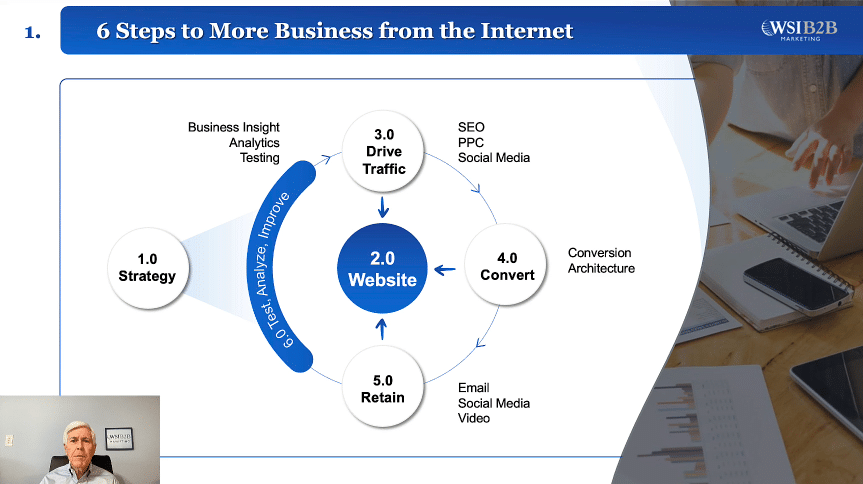Manufacturing Digital Marketing – What IS Digital Marketing?
November 24, 2015
Are you in a manufacturing company in the B2B space? Are you interested in growing and taking advantage of the recovering economy? If so, I would guess you are hearing a lot about “digital marketing” as an emerging “must do” for your company? Let’s define what that means in a narrow context of a “growth oriented”, “manufacturing company”, and “selling B-to-B products and services”
3 Pillars of Manufacturing Digital Marketing
Digital Marketing is best understood by clearly explaining the business processes that it addresses. For this narrow niche of b2b manufacturing companies, the three principal processes that digital marketing interacts with to create growth are:
- LEAD GENERATION – Prospect interest through becoming a sales qualified lead – This process starts with a qualified prospect becoming aware that he or she has a problem that may be solved by your products or services. This typically starts with a discussion with peers (social media) or a Google search for solving the problem. For us, Digital Marketing starts even before the prospect first visits one of your web properties. There are lots of steps on this process from website visits, lead nurturing emails, and eventually declaring the lead qualified and sales-ready, the end of our first process.
- CUSTOMER COMMUNICATIONS – Every digital communication with customers, prospects, ex-customers, friends of the company year in and year out – Here we are talking about email communications, your website being an industry resource, and social media.
- BRAND MANAGEMENT – Online branding efforts, social media, and reputation management – The old style mass marketing branding efforts just won’t work like they used to. Trade shows, brochures, and industry niche magazine advertising are quickly being replaced by online advertising, great websites, social media, and customer reviews as being the biggest impact on your brand.
In these three processes, we are limiting our definition to activities on digital devices, specifically excluding TV and radio. This is likely to get very grey in the next few years, but for now TV advertising, radio, PR, print, billboard and the more traditional marketing activities are outside what we consider digital marketing. These traditional marketing outlets are all “push” marketing and mostly mass-market, not targeted nearly as much as digital is.
In fact, adding “Pull” marketing into the mix is probably the biggest improvement digital marketing brings. It can put you in front of prospective clients early in their research phase when they are first looking for solutions.
What’s unique to manufacturing internet marketing as we describe it? Here are some key areas that make what we do truly unique:
- B2B – the set of solutions for selling to other businesses is different
- There is seldom a TV solution they have been used to using. Since most are national or global companies, TV advertising has never been in the mix
- Trade Shows, not TV or radio mass media advertising, have been the biggest marketing investment for these companies. That’s not going away, just becoming less effective
- Brochure thinking, not interactivity culture exists in most of these companies. They are just not used to interacting with end customers looking for information, being 100% up to date with technical information, and really being an information resource for their market space. These are foreign concepts to most B2B manufacturing companies
- Loss of control of their sales process is a major shift. These companies were always in control of product data, sales people had the power over customers, and customers knew they had to go through salespeople to get the information they needed. Digital marketing is now your first touch with new customers. It’s a proven fact that 80% of customers have been online and mostly completed their research before your company even knows they are looking for your products and services. The customer buying process in now in control of things!
So, no digital definition discussion would be complete without the Wikipedia definition, so here goes: Digital marketing is an umbrella term for the targeted, measurable, and interactive marketing of products or services using digital technologies to reach and convert leads into customers. The key objective is to promote brands, build preference and increase sales through various digital marketing techniques. (Underline emphasis is mine)
The CULTURE SHIFT of digital marketing is vital to understand. As businesses shift from traditional marketing to digital marketing, managers have to shift culture, often the hardest thing of all. Here are my Top 10 Culture shifts of the Digital Marketing age:
Thinking MOBILE as this is the biggest culture shift of all
- Giving away massive amounts of great, free content
- Measuring your marketing results, actually calculating ROI for each campaign
- Being truly interactive with your customers 24/7 on whatever device they choose
- Hearing what your customers have to say in reviews. Wanting the bad news with the good.
- Customer has control, not marketing or sales
- Fully recognizing your “online competition” in addition to your traditional competitors
- Using inexpensive YouTube Video to augment your professional video production
- One-on-One marketing like never before (since the neighborhood store)
- Every company has to have a robust marketing budget beyond brochures and trade shows to compete and grow
Here are some of the other terms used in digital marketing for manufacturers, most being subset components of Digital Marketing
- Internet Marketing – much the same as digital marketing. Digital marketing is a little broader in terms of the latest technologies
- Inbound Marketing – the HubSpot term empathizing lead generation of customers already looking for your solutions
- SEO – the specific work of generating high search engine rankings and driving targeted traffic to your web properties from “organic” or “natural” search
- Content Marketing – really a subset of SEO which is now content-centric
- SEM – the broader term of paying for search traffic, like AdWords or Facebook advertising
- Pay per Click – a subset of SEM paid advertising
- Email Marketing
- Social Media Marketing
- Mobile Marketing which is digital but not always over the Internet
- Video Marketing (except TV in my definition)
My favorite “common sense” definition is from Ryan Arnholt, Director of Digital Marketing at Optum when he said “Digital marketing starts with really rich content that people actually care about – including killer images. Then it’s delivering that content when and where your customers want it in hopes they like it and tell all their friends and followers. And make sure they can see it on a device that they use everyday, especially the one attached to their hip. But above all, don’t overwhelm people with your sales pitch. Keep it simple and teach them something so they consider you a valuable resource not just a company pushing product.”




